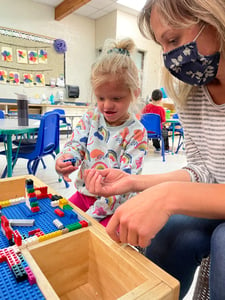You can’t tell somebody to calm down if their lid is flipped! Our ancestors, the brave cave people, lived lives full of danger. Because of the perils they faced, their brains were in a constant state of alert, and out of necessity, their amygdalas had to work hard to keep them alive. Our modern brains still hold the lessons learned during prehistoric times. When a student flips their lid their amygdala is where they live! We call this the fight, flight, freeze response.
Imagine your brain is like a house and the basement of your house is meant for safety and storage. In times of danger or threat, you will retreat to the basement in search of safety and protection. Students who have experienced trauma are very familiar with their basements, having spent much of their time in protection mode. The basement is their safe spot, their comfort zone, and a place that has kept them alive. In order to coax them out of this space and into a spot where learning is possible, we as educators must create an environment with this level of security.
The world of education is full of resources, positive behavior supports, and programs that focus on supporting the emotional regulation of our students. The tools and strategies presented have their merit but often lack the practical approach we seek when faced with the reality of the situation. The key problem is what happens when students aren’t able to choose a strategy. The student finds themself in the “red zone” and having a discussion about what strategy to use is too much. It’s fight, flight, or freeze…not “Hmmm I feel red. What should I do?”
A trauma-informed approach emphasizes that a student is hurt, not bad, and that although their behavior is disruptive and problematic it’s an adaptive response to their environment. They are not broken, so we don’t have to fix them. This is all about us, as the adults, presenting the skills to help students get out of the basement. Shifting our lens to a place of understanding student behavior versus managing it is crucial.
6 Key Strategies To Supporting Students
1. Stock up on food.
Food can be used as a dipstick to test where your student is at. Consider that you wouldn’t stop to pick up your picnic lunch if a grizzly bear is chasing you (crisis), but after you have calmed down, you will often be hungry (crisis over). Offering food or drink is a great strategy because it actually helps activate the sucking reflex (think baby brain) which can be calming. You can even try different textures of food to hit different sensory needs. Apples, carrots, or just a granola bar or juice box will all help students leave the flight, fight, freeze response. Even a lollipop! Whatever it takes to get that lid back on! When they’re in the middle of a panic response, students won’t be able to go grab their snacks, so make sure to have them easily accessible.
2. Think safety first.
Check the environment and decide if it is safe and if it preserves dignity. Removing the class is far safer in all aspects than physically removing the student who’s in the middle of a flight, fight, freeze response. If you have a student who regularly struggles, teach the class what the plan is when that student isn’t present. Your other students will understand and the plan will help them feel safe too.
3. Get some things to tinker with.
Legos, slime, playdough, coloring supplies, magnets, sand tables, the list goes on. High-interest items that occupy students’ hands are often helpful and one of the most utilized strategies when students merely dip into the basement. Let go of the thought that it is a reward, and reframe those activities as important regulation tools.

4. Stay calm.
Be vulnerable and reflect on how you have handled situations before. Where was your state of calm? Did you follow a set plan to handle the behavior? Safety can be felt so our response in these situations matters. The best place to start is to debrief a previous situation, identify how the adults can change their response, and build a plan! During a crisis, humans look for someone that “takes charge” because there’s safety there. If you have a plan before the crisis happens, you’ll feel calmer and grounded when it occurs.
5. Stop talking.
When s*** is going down, often the best thing we do is just shut up. Trust me, you are going to want to talk, ask questions, and tell your students to do things. You’ll be doing whatever you can think of to get the heck out of that situation and make the kid behave. Instead, think caveman! Minimal words and concise! “Let’s get juice.” “Office. Legos!” Simple and short is often the most effective way to communicate.
6. Give them time.
This has two parts: the time to get out of the basement and the time to regulate once they are out. This is a hard one that requires self-talk on the part of the adults and lots of patience. Giving the student time to get through this mess is vital. For some, it can be mere minutes, but for others it’s hours! For educators who work within the confines of school bells, this can be tricky. But what we have to lean on here is that the end goal will be to shorten the duration of the panic response. Don’t worry- the end goal is sustained regulated time in the classroom learning!
The basement of a student who has experienced trauma is their safe haven where they have weathered many storms. Although we may never know all the reasons or triggers that can cause a student to retreat to their basement, it is important that the adults work to understand the steps to help a student climb out. Just always remember that this is not about consequences, discipline, rewards, or bribes. This is about getting that lid back on so we can get out of the basement of the brain and eventually evolve this process to include restorative practices.
Your Student Did What? Part 1: Download a virtual handout with a scenario walk-through and even more tips.
Your Student Did What? Part 2: Download another virtual handout with even more information to help you manage students’ flight, fight, freeze responses.

.jpg)






